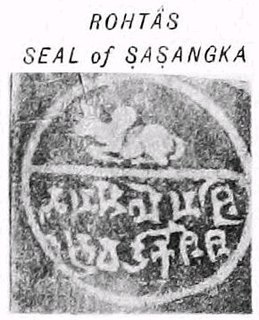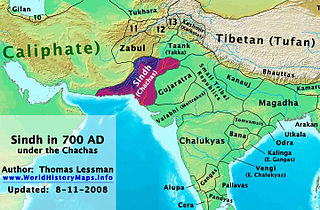Related Research Articles

The Middle kingdoms of India were the political entities in India from 200 BC to 1200 AD. The period begins after the decline of the Maurya Empire and the corresponding rise of the Satavahana dynasty, starting with Simuka, from 230 BC. The "Middle" period lasted for about 1,500 years and ended in 1200 AD, with the rise of the Delhi Sultanate, founded in 1206, and the end of the Later Cholas.

The Gurjara-Pratihara dynasty was an imperial power during the Late Classical period on the Indian subcontinent, that ruled much of Northern India from the mid-8th to the 11th century. They ruled first at Ujjain and later at Kannauj.

Harsha, also known as Harshavardhana, was an Indian emperor who ruled North India from 606 to 647 CE. He was a member of the Vardhana dynasty; and was the son of Prabhakaravardhana who defeated the Alchon Huna invaders, and the younger brother of Rajyavardhana, a king of Thanesar, present-day Haryana.

Shashanka also referred to as Gaudeshwar Maharajadhiraj Shashanka Deva was the sovereign Emperor of a unified polity in the Bengal region, called the Gauda Kingdom and is a major figure in Bengali history. He reigned in the 7th century, some historians place his rule between circa 600 CE and 636/7 CE, whereas other sources place his reign between 590 and 625 CE.
The Rai dynasty was a kingdom during the Classical period on the Indian subcontinent, which originated in the region of Sindh, later part of Pakistan. The dynasty at its height ruled much of the Northwestern regions of the Indian subcontinent. The influence of the Rai's extended from Kashmir in the east, Makran and Debal port in the west, Surat port in the south, and the Kandahar, Sulaiman, Ferdan and Kikanan hills in the north. It ruled an area of over 600,000 square miles (1,553,993 km2), and the dynasty reigned a period of 143 years.
Pulakeshin II was the most famous ruler of the Chalukya dynasty of Vatapi. During his reign, the Chalukya kingdom expanded to cover most of the Deccan region in peninsular India.
Chach Nama, also known as the Fateh nama Sindh, and as Tareekh al-Hind wa a's-Sind, is one of the main historical sources for the history of Sindh in the seventh to eighth centuries CE, written in Persian.
Samanta was a title and position used by the army people of kings in the history of the Indian subcontinent. India dating to the 6th century. The institution is considered to and is closely associated with the origin and growth of feudalism in India.

The history of Sindh or Sind refers to the history of the modern-day Pakistani province of Sindh, as well as neighboring regions that periodically came under its sway. Sindh has longer history of dynastic rule than any other province of Pakistan due to its relatively isolated location, as compared to Punjab and Balochistan. Sindh was a cradle of civilization as the center of the ancient Indus Valley civilization, and through its long history was the seat of several dynasties that helped shape its identity.
Chach was a Hindu Brahmin king of Sindh region of the Indian subcontinent in the mid-7th century CE. Chach expanded the kingdom of Sindh, and his successful efforts to subjugate surrounding monarchies and ethnic groups into an empire covering the entire Indus valley and beyond were recorded in the Chach Nama.
Rai Sahasi II (Sinha_sena/सिंह_सेन), was the last Hindu ruler of the Rai dynasty of the Sindh region of the Indian subcontinent, in first half of 7th century AD. The Emperors of Rai dynasty were great patrons of Hinduism and Buddhism. This is consistent with the historical accounts from the times of Emperor Ashoka and Harsha, as numerous monarchs from the Indian Subcontinent never sponsored a state religion and usually patronized more than one faith. He succeeded his father Sinharus.

The Tripartite Struggle for control of northern India took place in the ninth century, between the Pratihara Empire, the Pala Empire and the Rashtrakuta Empire.
The Ror dynasty was a power from the Indian subcontinent that ruled modern-day Sindh and northwest India from 450 BC. As capital of the Sauvira Kingdom, Roruka is mentioned as an important trading center in early Buddhist literature. Buddhist Jataka stories talk about exchanges of gifts between King Rudrayan of Roruka and King Bimbisara of Magadha. Divyavadana, the Buddhist chronicle has said that Ror historically competed with Pataliputra in terms of political influence. The scholar T.W. Rhys Davids has mentioned Roruka as one of the most important cities of India in the 7th century BCE.
The Mori is a Rajput clan which controlled the Chittor Fort in ancient period. They claim to be Agnivanshi, and trace their origin to the Parmar Rajputs.
Chandra or Chandar was a Brahmin ascetic who succeeded his brother, Chach of Alor, as king of Sindh region of the Indian subcontinent. An account of Chandar's reign is presented in the Chach Nama, a recording of this period of Sindhi history and the broader history of the Indian subcontinent.

The Brahman dynasty was a Hindu power on the Indian subcontinent which originated in the region of Sindh, present-day Pakistan. Most of the information about its existence comes from the Chach Nama, a historical account of the Chach-Brahman dynasty. The Brahman dynasty were successors of the Rai dynasty.

The Pushyabhuti dynasty, also known as the Vardhana dynasty, ruled parts of northern India during 6th and 7th centuries. The dynasty reached its zenith under its last ruler Harsha-Vardhana, whose empire covered much of north and north-western India, and extended till Kamarupa in the east and Narmada River in the south. The dynasty initially ruled from Sthanvishvara, but Harsha eventually made Kanyakubja his capital, from where he ruled until 647 CE.

The Later Gupta dynasty ruled the Magadha region in eastern India between the 6th and 7th centuries CE. The Later Guptas succeeded the imperial Guptas as the rulers of Magadha, but there is no evidence connecting the two dynasties; these appear to be two distinct families. The Later Guptas are so-called because the names of their rulers ended with the suffix "-gupta", which they might have adopted to portray themselves as the legitimate successors of the imperial Guptas.
References
- 1 2 Harsha and His Times: A Glimpse of Political History During the Seventh Century A.D. , Page 78 by Bireshwar Nath Srivastava (Chowkhamba Sanskrit Series Office, 1976)
- ↑ The historical background of Pakistan and its people by Ahmed Abdulla (Tanzeem Publishers, 1973)
- ↑ Chach Nama - The queen falls in love with Chach who becomes the Ruler through her love. - The passing away of Sáhasi Rái from this world.- Chach son of Seláij ascends the throne.